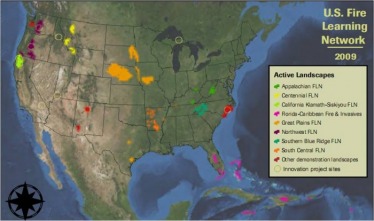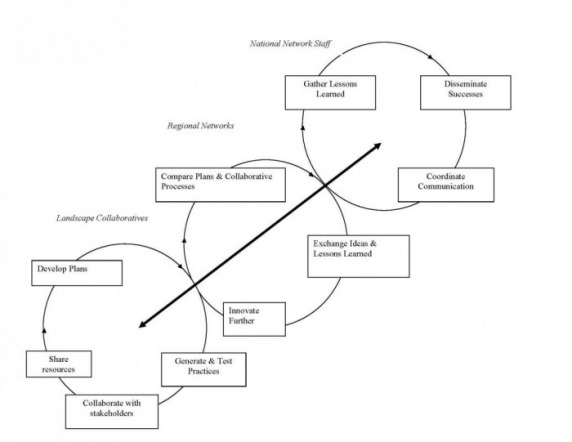The US Fire Learning Network

Map of the FLN as of October 2009
TNC, the USDA Forest Service (USFS) and land management agencies of the US Department of Interior (DOI) established the US Fire Learning Network (FLN) in 2002. Organizers aimed to catalyze the restoration of fire-dependent ecosystems through landscape-scale collaborative planning, regional capacity building, and national coordination. As of early 2009, a total of 14 regional networks and more than 150 landscape collaboratives involving over 650 partner organizations have participated in the network.
Overview of the Project
We have been engaged in studying the FLN since 2005, focusing on network design, function, and accomplishments. We have conducted more than 140 interviews, observed 15 regional and national meetings, and analyzed the rich document trail created by network members. Our outreach efforts have included assessing network leadership requirements, leading an FLN network leadership training, and providing results of our research at national network meetings.
We have been engaged in studying the FLN since 2005, focusing on network design, function, and accomplishments. We have conducted more than 140 interviews, observed 15 regional and national meetings, and analyzed the rich document trail created by network members. Our outreach efforts have included assessing network leadership requirements, leading an FLN network leadership training, and providing results of our research at national network meetings.
Peer-Review Publications
Goldstein, B. E., & Butler, W. H. (2009). The Network Imaginary: Coherence and Creativity within a Multiscalar Collaborative Effort to Reform U.S. Fire Management. Journal of Environmental Planning and Management, 52(8), 1013-1033.
Thumbnail summary: The FLN employed technologies, planning guidelines, and media to articulate a network imaginary coordinating independent efforts to engage in ecological fire restoration work without need for hierarchal authority or interpersonal relationships. This shared imaginary may allow the FLN to draw on the creativity and adaptive innovation of a network of collaboratives to contribute to changing fire management as a whole.
Thumbnail summary: The FLN employed technologies, planning guidelines, and media to articulate a network imaginary coordinating independent efforts to engage in ecological fire restoration work without need for hierarchal authority or interpersonal relationships. This shared imaginary may allow the FLN to draw on the creativity and adaptive innovation of a network of collaboratives to contribute to changing fire management as a whole.
| Network Imaginary.pdf | |
| File Size: | 2339 kb |
| File Type: | |
Goldstein, B. E., Butler, W. H., & Hull, R. B. (2010). The Fire Learning Network: A Promising Conservation Strategy for Forestry. Journal of Forestry. Vol 108, Issue 3. pp 120-125.
Thumbnail summary: The Fire Learning Network has improved conservation practices and empowered managers to address the challenges of reforming fire management at a national scale. It offers a model that could effectively address other persistent environmental and conservation challenges.
Thumbnail summary: The Fire Learning Network has improved conservation practices and empowered managers to address the challenges of reforming fire management at a national scale. It offers a model that could effectively address other persistent environmental and conservation challenges.
| The Fire Learning Network: A Promising Conservation Strategy.pdf | |
| File Size: | 226 kb |
| File Type: | |
Goldstein, B. E., & Butler, W. H. (2010). Expanding the Scope and Impact of Collaborative Planning: Combining Multi-stakeholder Collaboration and Communities of Practice in a Learning Network. Journal of the American Planning Association. Vol. 76, No. 2. pp. 238-249.
Thumbnail summary: There is a need to diversify and scale up collaborative planning. Creating a network of place-based stakeholder-based collaboratives through communities of practice can both strengthen individual collaboratives and achieve overall network synergies.
Thumbnail summary: There is a need to diversify and scale up collaborative planning. Creating a network of place-based stakeholder-based collaboratives through communities of practice can both strengthen individual collaboratives and achieve overall network synergies.
| Expanding the Scope and Impact of Collaborative Planning.pdf | |
| File Size: | 802 kb |
| File Type: | |
Goldstein, B. E., & Butler, W. H. (2010). The U.S. Fire Learning Network: Providing a Narrative Framework for Restoring Ecosystems, Professions, and Institutions. Society and Natural Resources. Vol 23, No 10: pp. 1-17
Thumbnail summary: The FLN mediated between central coordination and collaborative autonomy by guiding partners in the creation of place-based and mutually coherent stories that placed landscape partners within an arc of conflict, crisis and resolution. This aligned participants with the goals of FLN's sponsoring organizations while enhancing community solidarity and shared purpose.
Thumbnail summary: The FLN mediated between central coordination and collaborative autonomy by guiding partners in the creation of place-based and mutually coherent stories that placed landscape partners within an arc of conflict, crisis and resolution. This aligned participants with the goals of FLN's sponsoring organizations while enhancing community solidarity and shared purpose.
| The US Fire Learning Network: Provicing a Narrative Framework.pdf | |
| File Size: | 170 kb |
| File Type: | |
Butler, W. H., & Goldstein, B. E. (2010). The US Fire Learning Network: Springing a Rigidity Trap through Multi-scalar Collaborative Networks. Ecology and Society. Vol 15, No 3: 21.
Thumbnail summary: The FLN can enhance the resilience of forests and fire management organizations by serving as an incubator of innovation and experimentation at the landscape level, by informing forest management plans, and by shaping federal fire policy.
Thumbnail summary: The FLN can enhance the resilience of forests and fire management organizations by serving as an incubator of innovation and experimentation at the landscape level, by informing forest management plans, and by shaping federal fire policy.
| The US Fire Learning Netowkr: Springing a Rigidity Trap.pdf | |
| File Size: | 420 kb |
| File Type: | |
Goldstein, Bruce Evan and Butler, William. Collaborating for Transformative Resilience: Shared Identity in the US Fire Learning Network. Chapter 10 in Goldstein, Bruce Evan (ed.). Collaborative Resilience; Moving From Crisis to Opportunity. MIT Press, October 2011.
Thumbnail summary: How the FLN enhances resilience through collaboration at multiple scales.
Thumbnail summary: How the FLN enhances resilience through collaboration at multiple scales.
| Collaborating for Transformative Resilience.pdf | |
| File Size: | 477 kb |
| File Type: | |
Other Publications
Lalasz, Bob. (2010). The Fire Learning Network Goes Under the Microscope: An Interview with Lynn Decker, Will Butler and Bruce Goldstein. Science Chronicles, February: 21-26
Thumbnail summary: Interview with project PI's and the Director of the Fire Learning Network Lynn Decker, published in the Nature Conservancy's science magazine "Science Chronicles".
Thumbnail summary: Interview with project PI's and the Director of the Fire Learning Network Lynn Decker, published in the Nature Conservancy's science magazine "Science Chronicles".
| Science Chronicles 2011: The Fire Learning Network Goes Under the Microscope.pdf | |
| File Size: | 598 kb |
| File Type: | |

